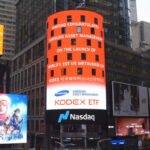Samsung attends FMS 2024, the international annual meeting of flash memory chipmakers in Santa Clara
Samsung Electronics Co., the world’s largest memory chipmaker, plans to unveil the industry’s highest-capacity enterprise solid-state drive (eSSD), BM1743, in November to compete with eSSD market leader Solidigm, a US-based NAND flash memory unit of SK Hynix Inc.
At an annual industry meeting of flash memory chipmakers in Santa Clara in California’s Silicon Valley, company executives said the development of the 128 terabyte (TB) eSSD will be completed by November this year.
Once launched, the BM1743 will be the industry’s highest-capacity quadruple-level cell (QLC) SSD.
Samsung already developed 64TB eSSD last month and is ready for mass production.
If successful, Samsung will be launching the industry’s highest-capacity eSSD product ahead of its crosstown rival SK Hynix’s NAND flash memory affiliate Solidigm, which is expected to unveil a 128TB eSSD early next year.
A Samsung executive unveils the company’s NAND strategy at FMS 2024
The 128TB product, using a seventh-generation QLC NAND flash, will have a sequential read speed of up to 7.5 gigabytes-per-second (GB/s) and a write speed of up to 3GB/s – twice as fast as Samsung’s previous-generation models.
Enterprise SSD, or eSSD, is a data storage device for servers. NAND flash is the main component of an eSSD, which also includes DRAM and a controller. With explosive demand growth for AI chips, eSSD is emerging as a core component of an AI chip alongside high-bandwidth memory (HBM) chips.
SAMSUNG FMS 2024
Samsung, the memory industry leader at the forefront of the artificial intelligence (AI) revolution, showcased its latest memory and storage products at the annual flash meeting, called the Future of Memory and Storage (FMS) 2024, which opened earlier this month.
Samsung’s BM1743 eSSD showcased at FMS 2024
At the FMS meeting, formerly known as the Flash Memory Summit, Samsung said it received the “Most Innovative Memory Technology” award for its BM1743 128GB QLC SSD.
Samsung showcased its eSSD products with capacities ranging from 16TB to 128TB.
At FMS 2024, Samsung also showcased its PM1753 low-power 16-channel SSD, designed to handle heavy write loads and large-scale training data, and the V9 triple-level cell (TLC) NAND technology.
SAMSUNG-SK HYNIX RIVALRY
Chipmakers are competitively unveiling new SSDs for individual and corporate uses to grab a greater share of the growing market.
Samsung’s V9 NAND technology showcased at FMS 2024
In August 2023, Samsung teamed up with US cloud software provider VMware Inc. to strengthen its SSD competitiveness.
According to market research firm TrendForce, Samsung controlled 41.7% of the global eSSD market as of the fourth quarter of 2023. SK Hynix and its affiliate Solidigm ranked second with their combined market share of 31.2%.
In the QLC-based high-capacity eSSD segment, SK Hynix and Solidigm control the market while Samsung is a fast follower.
SK Hynix, the world’s No. 2 memory maker has also unveiled a series of new SSDs to expand its presence in the corporate and consumer markets for high-capacity storage devices.
Samsung’s PCIe 5.0-based server SSD PM1743
TrendForce data showed the global enterprise SSD market expanded to $3.76 billion in the first quarter, up 63% from $2.31 billion in the fourth quarter of 2023.
QLC-based eSSD shipments, in particular, are forecast to rise fourfold to 30 exabytes (EB) this year from last year.
One EB is equal to one billion gigabytes (GB). An exabyte is large enough to take about 250,000 high-end home computers or 1 million average home computers to store this amount of data.
By Jeong-Soo Hwang
hjs@hankyung.com
In-Soo Nam edited this article.













